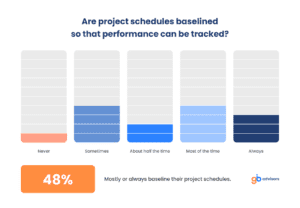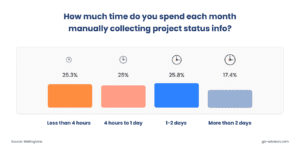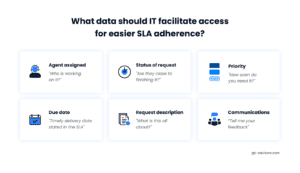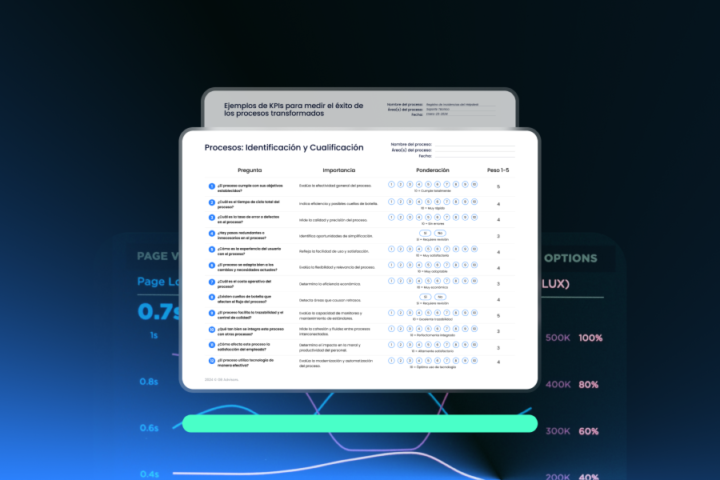As foundational arrangements with customers, SLAs compliance can be a resourceful tool to manage customer expectations and satisfaction.
Setting SLAs properly and assessing compliance can help you identify outages or performance issues.
SLAs were primarily oriented to service networks. However, they have now spread to IT Operation Management and Project Management as a new way to help measure and justify the figures involved in investments.

Knowing that almost half of the projects‘ baseline their projects in terms of schedules, we can start thinking of using SLAs for this goal.
Moreover, using SLAs helps establish a baseline for service (and project) quality, not only for project schedules.
How can you start implementing SLAs in project management? Through IT.
In this blog entry, we will walk you through the importance of IT in SLA use and compliance. Furthermore, we will tell you how to succeed in SLAs compliance in 5 simple steps.
Importance of IT in SLAs Compliance
To meet all the demands associated with this SLAs compliance, IT teams need to automate as many support and development tasks as possible.
For this reason, the pressure on IT to provide faster and more efficient services to allow systems to run without interruptions has been steadily increasing.
The integration of IT plays a significant role in SLAs compliance. Why? Because it optimizes the gathering and review of data, time segmentation and calculation of overall performance.
This leads to a better experience calculating if your SLAs compliance percentage is at risk, missed, or just less than the value established.
In an ever-changing business reality, project management needs to be able to forestall new scenarios through tools like IT.
This will help to anticipate risks and maintain operational capabilities through intelligent analysis and a bigger perspective given by IT.
5 steps to succeed SLAs compliance in Project Management
Integrate IT for SLAs Compliance
Using these tools help gather information about services in an easy-to-access interface for anyone in the company.
In this way, collaborators can:
- Interact officially with other areas when needed.
- Apply SLAs to the services they provide as a department.
- Use SLAs compliance as a performance boost.
Here is an example…
So, you have a B2B SaaS company that offers help desk software to help businesses improve customer service.
Your sales team is planning a meeting with a potential client to conduct a demonstration of the tool.
But, for this they need help from one of your certified support agents, who belongs to another department.
So, how can the sales team reach out for help?
Perhaps email or private chat? This looks like a nightmare for project traceability.
With the help of IT (an IT Service Management Software), you can gather, in an interface, all services offered within the organization.
These services can be requested when needed, and each area can configure everything regarding its own services (including SLAs).
What happened with the demo? With the help of IT and SLAs in place, things should have gone smoothly because:
- The request arrived at the service provider within seconds
- Your sales team got a response from them within the first hour (as stated in the SLA)
- Communications about the request could be located in the ITSM tool, helping project traceability and collaboration
In the end, everyone knew their responsibilities and the expectations from their counterpart, as there was no space for miscommunication.
2. Work on decreasing business risks
How can you decrease business risks better than assessing them before they arrive as problems?
Integrating IT in the mix of SLAs compliance and project management helps you count on predictive trending and analytics. This helps identify difficulties and shortcomings before they have a negative effect on the business.

In this regard, knowing that almost 50% of PMOs do not have real-time access to KPIs, having an ITSM tool helps you measure team performance in terms of SLAs compliance.
This awareness of the actual performance of the teams acting as service providers is crucial for further analysis.
In addition, the analysis of this information can yield data on possible points of improvement. This, has a long-term positive impact on the continuous improvement of processes across the organization.
Here is an example…
In terms of automation, IT helps you automate simple tasks such as SLA expiration reminders or the creation of service requests.
If the first response for a service request for any department is about to expire, all team members can receive an automatic notification before breaching the SLA.
In case of an SLA breach, things can be escalated by automatically notifying the area manager. This helps mitigate any risk arising from the breach.
On the other hand, automation can be applied not only to notifications. Through IT, you can also automate the process of creating a request.
In this way, it will be enough to fill out a form -for example- and, in a matter of seconds, the service request and all the related information will reach the provider.
This helps employees save time when creating a request. Consequently, the responsible employee knows if a deadline is about to expire or if there was no first response to the request.
On the other hand, by complementing this with the implementation of SLAs, you can measure how effectively a particular team is performing.
What do you gain from this?
Employees will be more focused on tasks their roles demand, especially those whose projects depend on collaboration with other areas of the organization.
Moreover, you will count on predictive trending and analytics to identify difficulties and shortcomings before they have a negative effect on the business.
Finally, this will help minimize risks as any analysis coming from the performance data in terms of SLAs compliance to make decisions about inefficiencies.
3. Simplify modification in requests:
An ITSM tool organizes workflows and allows the possibility of managing this information with features aimed to:
- Ease the supervision of multiple stakeholders.
- Centralizing information flow regarding service requests/deliveries.
- Unifying a communication channel to all parties involved.
By simplifying these areas, any change in the project involved in the service request would be timely and thoroughly managed.
Here is an example…
So, your company’s software development team has an SLA for landing page implementation delivery on your website.
This SLA states that a timely delivery for this service should not exceed five business days.
Your marketing team requested this service and, in the middle of the process, came up with several changes to the content and design of the deliverable.
What is the problem? They didn’t notify these changes until two days before the SLA stated delivery date…
This would have all been avoided if there were a platform or app, or software that centralizes information flow about the requests.

This list above can go on and on, depending on your specific needs.
However, in this regard, you need to consider every possible piece of data that improves the user experience for the client (service requester) and the service provider.
All this will help manage any sudden changes related to the request, maximizing SLAs compliance and facilitating timely deliveries.
4. Engage the business personnel
IT service management provides a platform from which everyone is informed and can interact with other areas.
And by everyone, we mean IT and non-IT collaborators.
This means that any collaborator across your organization can exploit an improved collaboration experience through IT solutions.
This collaboration will also impact the commercial goals of the organization, since the individual success of multiple areas within the organization means success for the organization as a whole.
Here is an example…
The collaboration part is somewhat clear up until now.
However, how can IT make this collaboration effective for SLA adherence?
First, every team across the organization will know how every other team in the organization can help them.
Secondly, if they need help from another department, they will know where to look for the service and how to make a service request.
Thirdly, service requesters will save time making requests, since it will be easier for the service provider to give a fast first response.
Finally, since all aspects of service requests will be in one place, making SLAs compliance easier.
Why? Because every piece of information needed to fulfill the request is a couple of clicks away.
5. Monitor SLAs compliance
This step could be considered a complement to step 2 (Reduce business risks).
Why? Because the improved access and management of information through IT support, makes it easier to access key information on SLA compliance and equipment performance.
As a result, it will be much easier to closely monitor SLAs compliance rates over the long term.
Here is an example…
With the help of IT (tools such as IT service desks) with SLAs compliance, not only can we automate escalated case notifications.
We can also facilitate the monitoring of aspects such as SLAs compliance or equipment performance.
How? Through tools with customized dashboards, where you can find all the data, KPIs, or metrics on specific areas.
On the other hand, to give another layer of optimization to this aspect, it is possible to automate the generation and sending of reports to interested parties.
With this, long-term SLAs compliance will be more effective in all areas of the organization.
Succeed SLAs compliance

Since SLAs compliance percentage must be reviewed periodically, the advantages of integrating and relying your company’s tasks on an effective automated solution will save time and effort to successfully achieve SLA adherence.
Moreover, it will guarantee both business users and customer satisfaction due to the tangible improvement in the company’s environment and overall performance.
By staying within SLAs compliance and keeping a timely delivery in your commitments, customers (all service providers) can bring more value to the business.
Why? Because they will know that they can always count on resources to help them with their projects and respective goals.
Whether a company merges, grows, or experiences a sudden higher demand, relying on tools that improve processes through automation or SLAs is crucial to keeping track of things in Project Management.
In this sense, it is mandatory to forestall scenarios to track performance, anticipate possible pitfalls in processes and make continuous improvements in every aspect of the organization.



